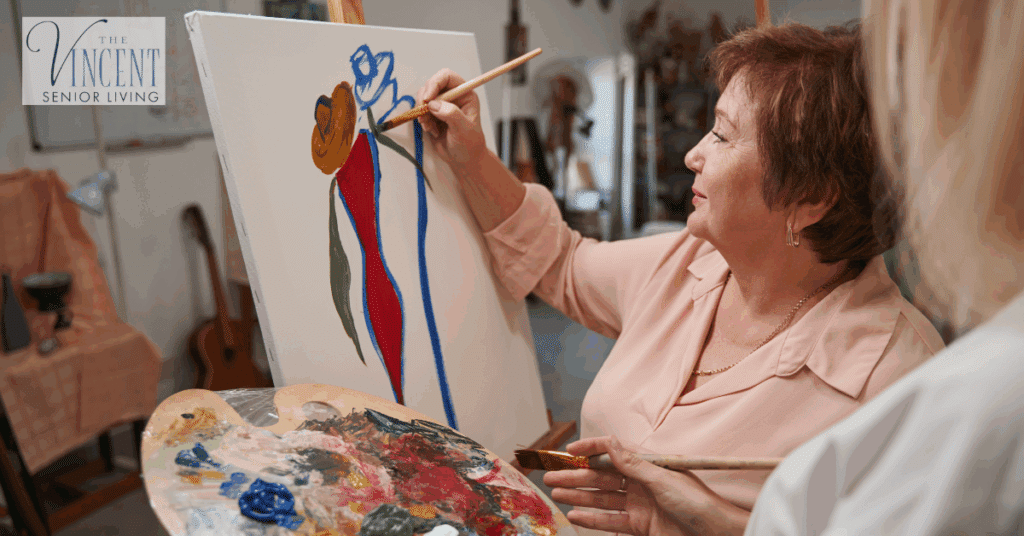Living with a loved one who has dementia brings unique moments. Some days flow smoothly. Others test your patience when anger surfaces unexpectedly. In senior memory care communities, care partners...
Read more
Art Therapy and Dementia Care: A Powerful Approach to Alzheimer’s Support

Memory loss, fatigue, mood swings, and declining cognitive abilities are realities many older adults and their families face. These challenges become even more pronounced with conditions like Alzheimer’s disease. Finding creative ways to support loved ones through these changes is crucial. Art therapy and dementia care have emerged as a remarkably effective combination, offering hope and healing through artistic expression. This therapeutic approach brings joy and connection to those who need it most.
What is Art Therapy?
Art therapy blends creative work with psychological support to nurture mental and emotional well-being. It rests on a simple yet profound truth – creating art can heal, provide relief, and help people understand themselves better. The process itself matters more than any finished product. Art therapy and dementia work together to create meaningful moments of self-expression.
For those living with Alzheimer’s or dementia, artistic pursuits become a lifeline when words fail. Trained art therapists guide residents through projects that spark purpose and build confidence. Nobody expects masterpieces. The real magic happens when someone picks up a brush, shapes clay, or arranges a collage. They’re not just making art – they’re expressing who they are, maintaining their dignity, and experiencing pure joy. Art becomes their voice when other forms of communication grow difficult.
Types of Art Therapy for Dementia Care
Creative expression in memory care communities takes many wonderful forms. Each approach offers unique ways for individuals with dementia to connect with themselves and others. The versatility of art therapy and dementia support allows care partners to match programs to individual interests and abilities.
- Visual Arts: Drawing, painting, and collage-making let each person share their inner world through colors and shapes. These projects open doors to emotional outlets that words can’t always reach.
- Sculpture: Clay work and three-dimensional creations bring texture into the therapeutic process, strengthening sensory awareness while exercising fine motor skills.
- Music and Movement: Rhythms and melodies woven into creative activities awaken memories and invite emotional release. Movement paired with music creates powerful moments of connection.
- Drama and Role-Play: Stories come alive through dramatic interpretation. Residents draw from their life experiences, sharing their emotions through character and narrative.
- Multimedia: Photography meets traditional art. Digital tools blend with hands-on creativity. These multi-sensory combinations capture attention and spark engagement in fresh, exciting ways.
Benefits of Art Therapy for Seniors with Dementia
The positive impact of creative activities reaches far beyond the art room. Art therapy for seniors with dementia transforms daily life in remarkable ways, touching every aspect of well-being.
Strengthening Brain Function
Creating art lights up the brain like fireworks. Problem-solving kicks in when choosing colors. Decision-making happens with every brushstroke. Planning unfolds as projects take shape. This mental workout helps maintain precious abilities. Regular creative practice may even slow the progression of memory-related changes. Art therapy and dementia research consistently show these cognitive benefits.
Improving Motor Skills
A paintbrush becomes a tool for physical therapy. Sculpting clay exercises fingers and hands. These movements improve coordination between eyes and hands while building dexterity. Better motor function supports independence in daily activities. Residents who paint today might button their shirts more easily tomorrow. The connection between art therapy and dementia care extends to physical wellness, too.
Reducing Anxiety, Agitation, and Stress
A study discovered that simple, repeated artistic movements create a calming rhythm that quiets racing thoughts. These gentle practices shift focus away from distress toward peaceful engagement. The intersection of art and dementia reveals how creative engagement naturally eases behavioral challenges.
Stimulating Memory Recall
Art therapy for Alzheimer’s patients often unlocks forgotten treasures. Projects connected to personal interests – painting a childhood home, recreating a favorite flower garden – bring memories floating to the surface. These cognitive exercises keep the mind active and engaged. Art therapy and dementia specialists design sessions specifically to trigger these important recollections.
Boosting Self-Esteem and Confidence
Completing an art project brings genuine accomplishment. Care partners celebrate each creation. Peers admire finished pieces. This positive feedback builds self-worth in powerful ways, helping each person feel valued and capable. Benefits of art therapy for dementia include this vital confidence boost that helps residents face daily challenges with renewed strength.

Building Social Connections
Research confirms that group art sessions create deep and meaningful bonds between participants. Conversations flow naturally over shared supplies. Friendships bloom in the art room. Art therapy and dementia group sessions foster these essential social connections.
Fostering Emotional Well-Being
Complex emotions find safe expression through art. By expressing themselves creatively, seniors can explore complex emotions such as grief, fear, and anger, which may otherwise be difficult to process.This self-exploration brings understanding and acceptance. Dementia and art therapy work together to nurture emotional health in profound ways.
Improving Communication Skills
When words become elusive, art speaks volumes. Communication through artistic means bypasses verbal limitations. A painting might say what speech cannot. Sculptures express feelings too deep for words. This non-verbal dialogue keeps connections between family members alive. Art therapy and dementia specialists understand this unique communication pathway.
Creating Good Moments and Enhancing Mood
Simple art projects bring unexpected joy. Even non-verbal residents light up when handed art supplies. Art therapy with dementia consistently produces these precious moments of happiness that transform difficult days.
The Power of Art Therapy in Dementia Care
Creative expression offers transformative possibilities for those living with memory challenges. Art therapy and dementia care combine to preserve identity, maintain dignity, and create meaningful relationships. Through painting, sculpting, and creating, residents discover new ways to engage with life. Cognitive function gets support, motor skills improve, and anxiety decreases while social bonds strengthen. These benefits touch every aspect of daily living, from morning routines to evening relaxation.
At The Vincent Senior Living Community, we’ve witnessed firsthand how art enriches lives. Our specialized memory care programs, including comprehensive artistic therapies, help your loved one thrive in a compassionate, innovative environment. Schedule a personal tour now and discover our innovative approach to memory care, where art therapies help your loved one flourish in a supportive, compassionate environment.
Related Posts
Visiting a loved one in memory care creates opportunities for connection and shows how much you care, though these moments can stir up complex emotions. You want to be supportive...
Read moreWhen a family receives an Alzheimer's diagnosis for someone they love, the path forward can feel uncertain. Memory fades, cognitive abilities shift, and decisions about care become urgent. Many families...
Read moreRecent Posts
Related Posts
Living with a loved one who has dementia brings unique moments. Some days flow smoothly. Others test your patience when anger surfaces unexpectedly. In senior memory care communities, care partners...
Read moreVisiting a loved one in memory care creates opportunities for connection and shows how much you care, though these moments can stir up complex emotions. You want to be supportive...
Read moreWhen a family receives an Alzheimer's diagnosis for someone they love, the path forward can feel uncertain. Memory fades, cognitive abilities shift, and decisions about care become urgent. Many families...
Read more



